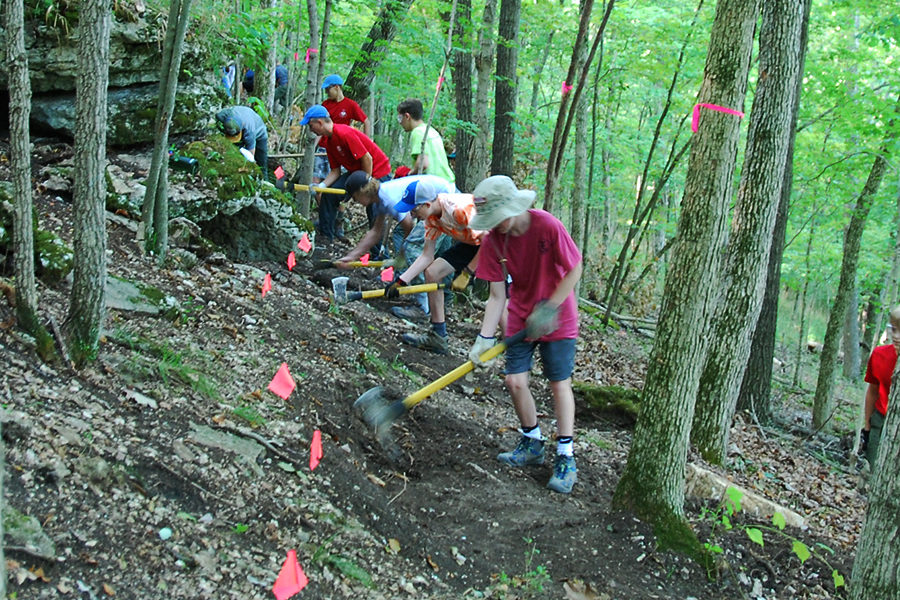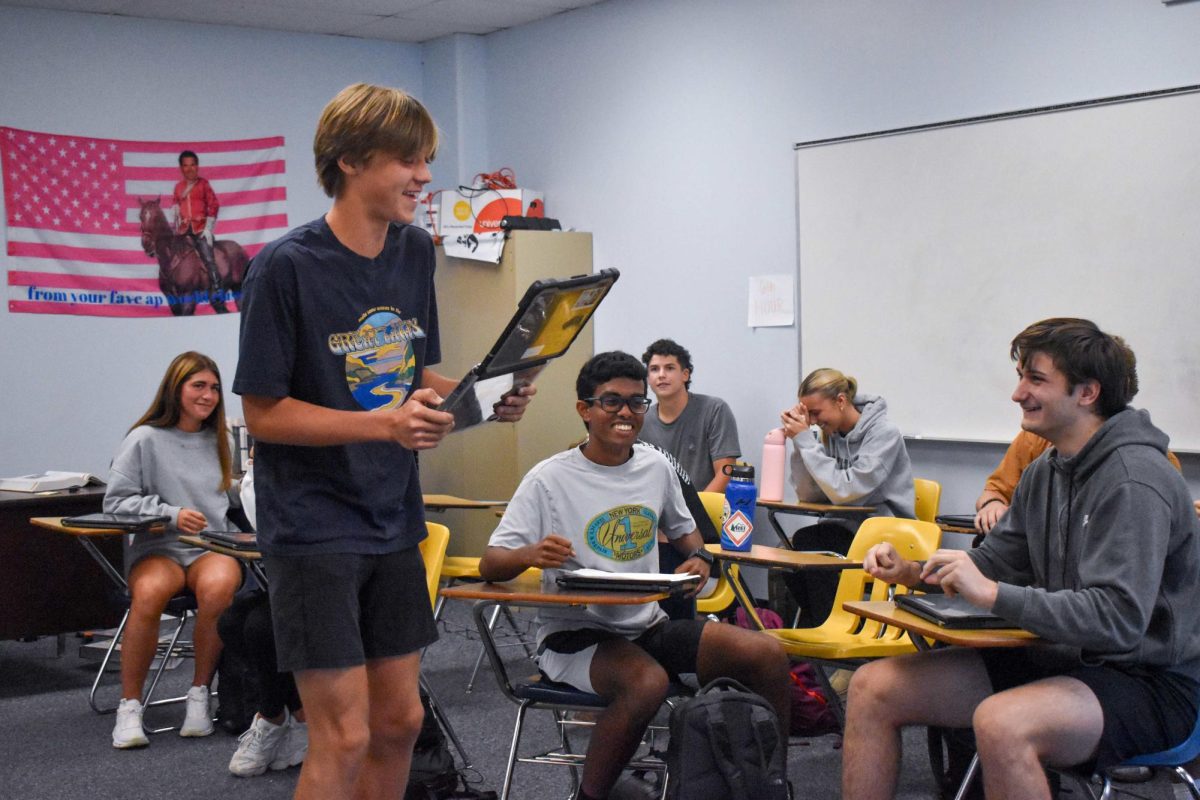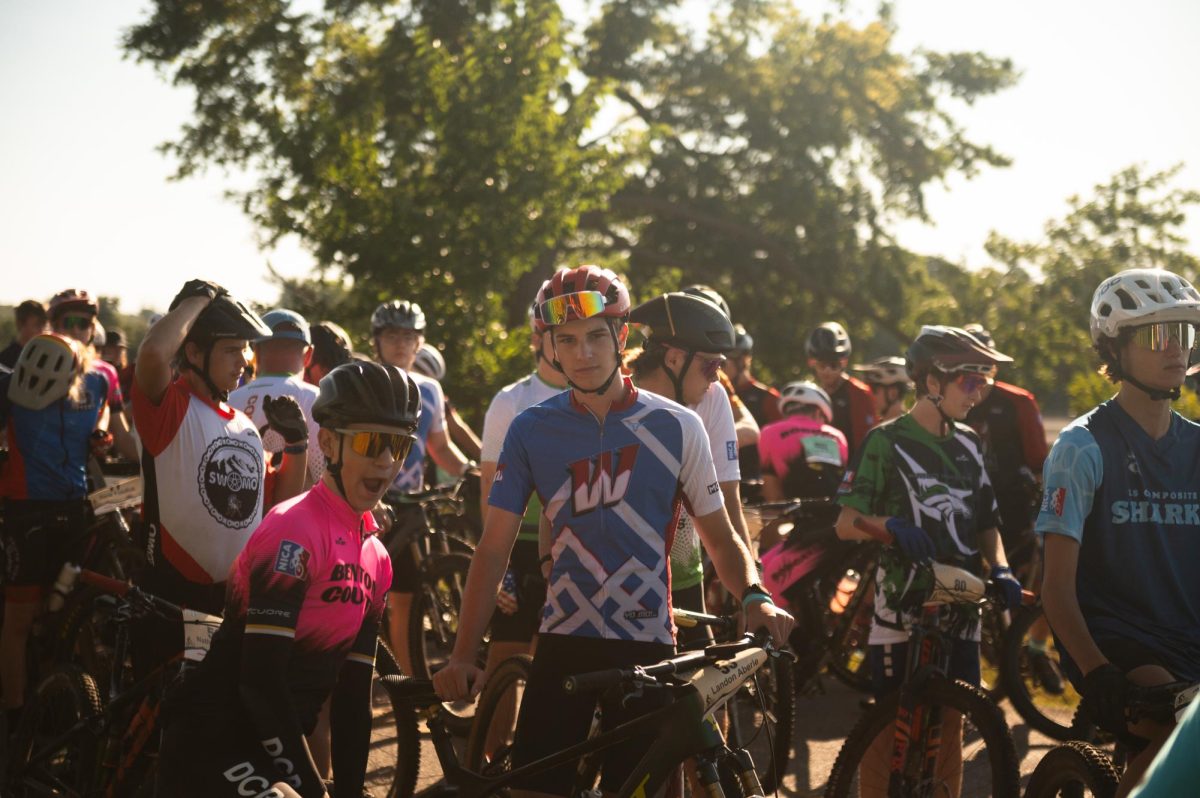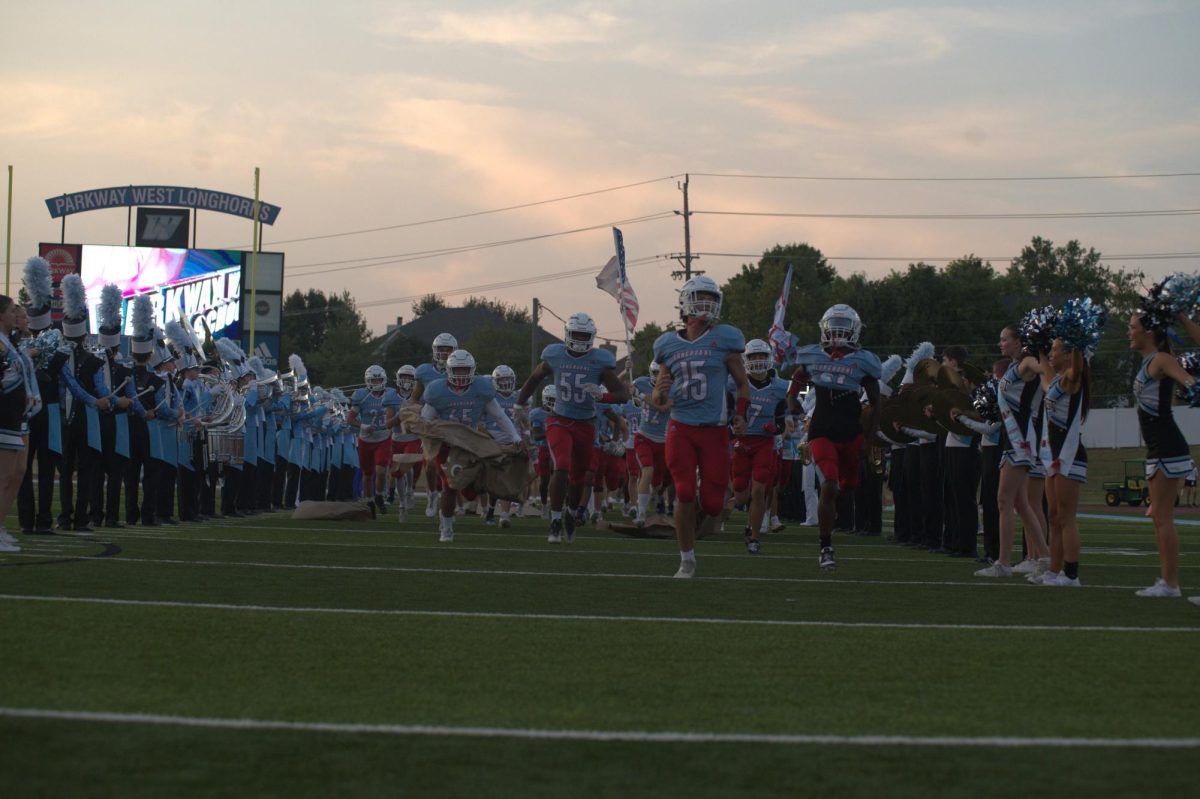People of all ages enjoy walks in the woods and exciting bike rides through the hills year round, but the hard work that goes into the construction of those paths is not widely known. Senior Adam Johnson has been helping the Gateway Off-Road Cyclists (GORC) build several miles of trail in the St. Louis area.
“I’ve been trail building since I was 8 years old, so about 10 years,” Johnson said. “My dad used to be a professional mountain biker and he’s always been involved in the mountain biker community; this group builds mountain biking trails. So he’s been involved with them for a long time, and brought me along when I was young.”
While his dad may have been the reason he first started coming to trail builds, Johnson’s continued involvement in the outdoors and trails can be attributed elsewhere.
“I’m pretty involved in Boy Scouts. And I think that the idea that Boy Scouts push to help other people and take care of the world that you live in really played a big part in my wanting to build trails. You have a chance to give back to the community and build something outdoors,” Johnson said. “Building mountain bike trails gives you the the opportunity to experience nature while working on building something that will last a lifetime.”
Johnson does most of his trail building through an organization called GORC.
“GORC is comprised of not only cyclists, but hikers [and] equestrians,” Adam’s dad and GORC member Mitch Johnson said. “[GORC] attains grants to buy tools, rent machinery and whatever we need, but also educates its members to design, work with land managers and build and maintain trails.”
These trail builders have put in 5,575 volunteer hours across 18 different trails in 2017 alone. Well over 3,000 of those hours have been on Wildwood’s Rock Hollow trail.
“I think we’re close to 400 members right now. But a lot of people never come out. Average workday is around 30 to 50 GORC members,” member Glenn Meyer said.
Despite a large member base, non-member volunteers do a great deal to help during build days. A. Johnson advised aspiring trail builders to do their research, and figure out how to get involved.
“If a student was interested in trail building they could go on the GORC website and get information about the workdays,” A. Johnson said. “They [build] just about every week, and they’re always open to new volunteers. It’s a lot of fun.”
While work on trails is done nearly year-round, most of the organized workdays happen during the fall and spring seasons.
“A typical season is gonna be about eight or ten workdays in a spring season or fall season,” M. Johnson said. “Fall starts in September goes all the way to December. This year is a little bit shorter. But typically eight to 10 workdays in a season, so maybe 15 to 20 a year.”
Despite the primary user group of these trails being mountain bikers, they are far from the only people that use the paths.
“Trail [running] has actually gotten to be a huge, huge thing. And they absolutely love what we’ve done with the trail,” M. Johnson said. “Because they want distance, they want trails to become longer and harder and more difficult, and so trail runners are a big part of it.”
Meyer is happy that their trails play such a big part in the enjoyment of the outdoors for people of all walks of life.
“It benefits anyone in the community who is active. Be it an equestrian, be it a hiker, a trail runner, a birder—it opens up the opportunity to go trail riding together,” Meyer said. “You don’t have cars driving right past you as you’re riding. You can see the different trees, you can see the colors of the leaves in the fall and you can see wildflowers in the spring. It gives the community a place to go where you can get a little more quiet.”




![Freshman Daphne Stokes looks at a table with Veterans Day flyers and information on Nov. 11. Stokes, along with other West High students, like senior Alexander Lewinski, passed by the table in the cafeteria with army recruitment information and giveaways for students to observe during lunch. “Talking with [the recruiters] has definitely helped me [find] where I wanted to go, more than anything else,” Lewinski said.](https://pwestpathfinder.com/wp-content/uploads/2025/11/DSC_1227-2-1200x800.jpg)
![Helping a customer, print room assistant Gretchen Williams operates her booth at the West High Craft Fair from Oct. 25-26. This was Williams’ first time participating in the Craft Fair with her new craft shop, Gs Beaded Boutique. “People have always said, over the years, ‘you should open something.’ [I replied that] I would rather just make [my crafts as] gifts for people. I just started [the online store] up, and it's been okay. I'm always surprised [by] how many views I get and [the] people from different states buying things; somebody from Alaska bought something the other day.”](https://pwestpathfinder.com/wp-content/uploads/2025/11/DSC0451-2-1200x799.jpg)
![Gesturing toward the club’s name on the board, Global Youth Aid co-president year Daniah Alsagheer discusses upcoming service projects with members during a meeting on Oct. 30. “We might be one club at one school, but together, we’re [part of] something much bigger,” Alsagheer said.](https://pwestpathfinder.com/wp-content/uploads/2025/11/DSC00949-1200x800.jpg)
![Focused on providing exceptional service, sophomore Darsh Mahapatra carefully cleans the door of a customer’s car. Mahapatra has always believed his customers deserve nothing less than the best. “[If] they’re trusting us with their car and our service, then I am convinced that they deserve our 100 percent effort and beyond,” Mahapatra said.](https://pwestpathfinder.com/wp-content/uploads/2025/10/DSC_0018-1200x800.jpg)
![Sophomore Aleix Pi de Cabanyes Navarro (left) finishes up a soccer game while junior Ava Muench (right) warms up for cross country practice. The two came to Parkway West High School as exchange students for the 2025-2026 school year. “The goal for the [exchange] program is to provide opportunities for both Parkway students and our international exchange students to learn about other cultures, build connections and become confident, capable, curious and caring — Parkway’s Four C’s — in the process,” Exchange Program Lead Lauren Farrelly said.](https://pwestpathfinder.com/wp-content/uploads/2025/10/Feature-Photo-1200x800.png)

![Gazing across the stage, sophomore Alexis Monteleone performs in the school theater. The Monteleone family’s band “Monte and the Machine” has been releasing music since 2012, but Alexis started her own solo career in 2024 with the release of her first single, Crying Skies. “My whole family is very musical, [and I especially] love writing [songs with them],” Monteleone said.](https://pwestpathfinder.com/wp-content/uploads/2025/09/DSC7463-1200x798.jpg)
![Amid teaching a lesson to her AP Calculus BC class, Kristin Judd jokes alongside her students in their funny remarks. Judd has always enjoyed keeping the mood light in her classroom, along with on the volleyball court. “[I enjoy] that side talk where you see [or] overhear a conversation and chime in, or somebody says something funny,” Judd said.](https://pwestpathfinder.com/wp-content/uploads/2025/09/image-1200x730.jpg)
![Eyeing the ball, junior Ella McNeal poses for her commitment pictures at Clemson University. McNeal’s commitment comes after months of contact with top Division 1 soccer programs. “ It has taken a lot to get to where I am, but I know that [what] I've already been through is just the beginning, and I can't wait for what is to come,” McNeal said.](https://pwestpathfinder.com/wp-content/uploads/2025/09/IMG_4926-1200x900.jpeg)

![Sophomore Shree Sikkal Kumar serves the ball across the court in a match against Lindbergh. Sikkal Kumar has been a varsity member of the varsity girls’ tennis team for two years, helping her earn the number two rank in Class 2 District 2.“When matches are close, it’s easy to get nervous, but I [ground] myself by[staying] confident and ready to play,” Sikkal Kumar said.](https://pwestpathfinder.com/wp-content/uploads/2025/11/DSC2801-1200x798.jpg)
![Dressed up as the varsity girls’ tennis coach Katelyn Arenos, senior Kate Johnson and junior Mireya David hand out candy at West High’s annual trunk or treat event. This year, the trunk or treat was moved inside as a result of adverse weather. “As a senior, I care less about Halloween now. Teachers will bring their kids and families [to West’s Trunk or Treat], but there were fewer [this year] because they just thought it was canceled [due to the] rain. [With] Halloween, I think you care less the older you get,” Johnson said.](https://pwestpathfinder.com/wp-content/uploads/2025/10/DSC00892-1-1200x800.jpg)
![Leaning on the podium, superintendent Melissa Schneider speaks to Parkway journalism students during a press conference. Schneider joined Parkway in July after working in the Thompson School District in Colorado. “My plan [to bond with students] is to get things on my calendar as much as possible. For example, being in [classes] is very special to me. I am trying to be opportunistic [meeting] kids [and] being in [the school] buildings. I have all the sports schedules and the fine arts schedules on my calendar, so that when I'm available, I can get to them,” Schneider said.](https://pwestpathfinder.com/wp-content/uploads/2025/09/IMG_5425-1200x943.jpeg)

![Leaping through the air, senior Tyler Watts celebrates his first goal of the season, which put the Longhorns up 1-0 against the Lafayette Lancers. Watts decided to play soccer for West for his last year of high school and secured a spot on the varsity roster. “[Playing soccer for West] is something I had always dreamed of, but hadn’t really had a good opportunity to do until now. It’s [really] fun being out [on the field], and I’m glad I decided to join the team. It’s just all about having fun with the boys and enjoying what time we have left together,” Watts said.](https://pwestpathfinder.com/wp-content/uploads/2025/09/DSC_1951-1200x855.jpg)

![Shifting global trade, President Donald Trump’s tariffs are raising concerns about economic stability for the U.S. and other countries alike. “[The tariffs are] going to pose a distinct challenge to the U.S. economy and a challenge to the global economy on the whole because it's going to greatly upset who trades with who and where resources and products are going to come from,” social studies teacher Melvin Trotier said.](https://pwestpathfinder.com/wp-content/uploads/2025/05/MDB_3456-1200x800.jpg)

![Pitching the ball on Apr. 14, senior Henry Wild and his team play against Belleville East. Wild was named scholar athlete of the year by St. Louis Post-Dispatch after maintaining a high cumulative GPA and staying involved with athletics for all of high school. “It’s an amazing honor. I feel very blessed to have the opportunity to represent my school [and] what [it] stands for,” Wild said.](https://pwestpathfinder.com/wp-content/uploads/2025/05/unnamed-6-1200x714.jpg)
